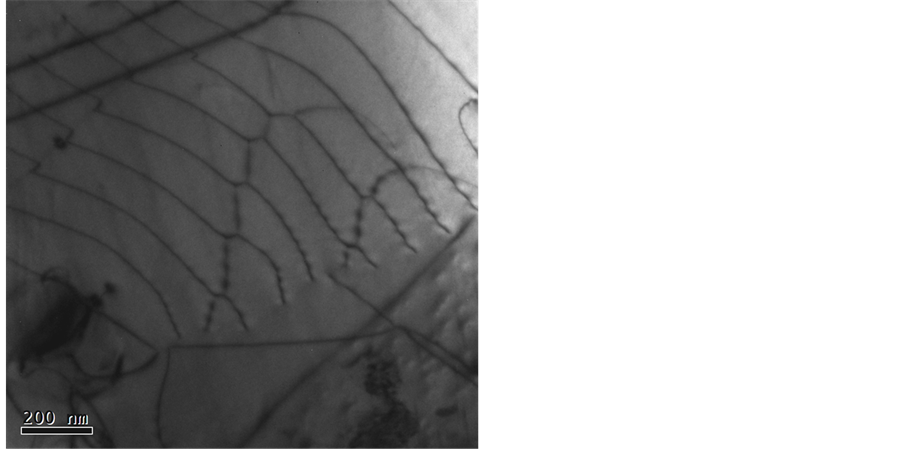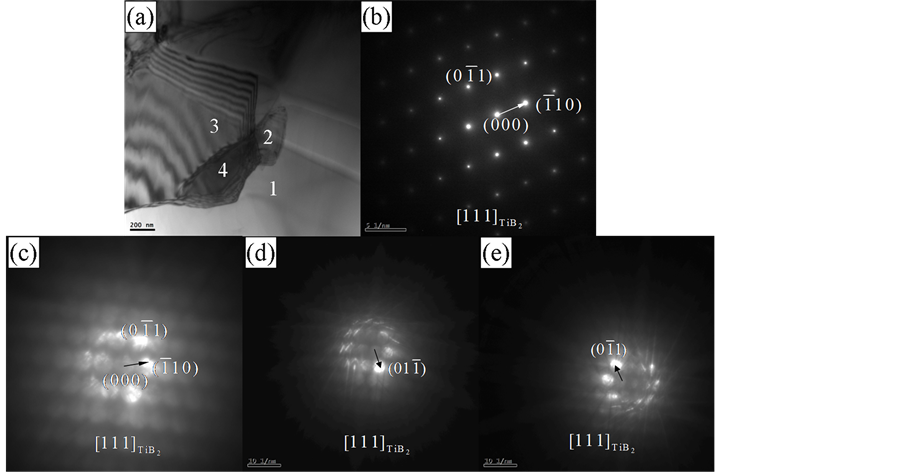Microscopy Research
Vol.2 No.3(2014), Article
ID:48383,5
pages
DOI:10.4236/mr.2014.23007
TEM Characterization of Dynamic Recrystallization in TiB2 Particles after Hypervelocity Impact
Q. Guo1*, J. F. Li1, L. L. Hou2, D. L. Sun3
1Western Superconducting Technologies Co. Ltd., Xi’an, China
2Institute of Information Engineering, Xi’an Technological University, Xi’an, China
3School of Materials Science and Engineering, Harbin Institute of Technology, Harbin, China
Email: *guoqianghit@gmail.com, *325guoqiang@163.com
Copyright © 2014 by authors and Scientific Research Publishing Inc.
This work is licensed under the Creative Commons Attribution International License (CC BY).
http://creativecommons.org/licenses/by/4.0/



Received 14 May 2014; revised 16 June 2014; accepted 25 July 2014
ABSTRACT
Characteristic of dislocations and dynamic recrystallization in TiB2 particles associated with hypervelocity impact craters in 65 vol.% TiB2/Al composite were investigated by transmission electron microscopy (TEM). As high temperature due to hypervelocity impact can make the dislocation climb, a bunch of vacancies were generated and then gathered to form vacancy slice, finally formed dislocation rings. In addition, by climbing, edge dislocations rearranged themselves into wall vertical with slip plane, which finally forms sub grain boundary. Moreover, big angle grain boundaries were observed, which demonstrates that dynamic recrystal grains were formed in impacted TiB2 particles. As a result, deformation behavior of TiB2 particles in 65 vol.% TiB2/Al composite under hypervelocity impact includes generation of dislocation, slip and climb of dislocation, and dynamic recrystallization.
Keywords:Impact, TiB2 Particle, Dynamic Recrystallization

1. Introduction
Studies on the microscopic damage of different alloys (including aluminum, titanium, copper, steel, magnesium alloys etc.) subjected to high-speed impact have been reported [1] -[7] . Compared with different alloys, microstructure characteristic of composites after impact should be quite different. Residual microstructures associated with hypervelocity impact craters in 55 vol.% TiB2/2024Al composite were investigated [8] . A new AlxO1-x phase with the fcc structure and the crystal parameter of 0.69 nm was formed at TiB2-Al interface.
Four characteristics were found in Al2O3 and TiB2 particles reinforced 2024 Al composite after high speed impact [9] : stacking faults around TiB2 particle and dislocations within the TiB2 particle; twins in the Al2O3 particle; recrystal grains in 2024 Al matrix; and mixture of amorphous microstructure and nanograins in the matrix. In present paper, 65 vol.% TiB2/Al composite was fabricated and damage behaviors and residual microstructure of TiB2 particles were studied.
2. Material and Methods
65 vol.% TiB2/Al composite target with the diameter of 85 mm and thickness of 15 mm was fabricated using pressure infiltration method [10] . 2024Al alloy spherical projectile with the diameter of 1.5 mm, which belong to the typical size of space debris in the near earth space, was launched from a two-stage light gas gun with the impact velocity of 3.5 km/s. The impact experiment was conducted in air conditioned atmosphere. In present study, sample for transmission electron microscopy (TEM) observation was prepared by the following steps: the slice which is tangent with the bottom of crater as depicted in Figure 1, was firstly cut from the target; then it was grinded to 60 μm in thickness. Afterward, a disc with diameter of 3 mm including the region around the tangent point was cut from the slice and ion thinned. TEM was performed on Tecnai G2 F30 type high-resolution transmission electron microscopy with an accelerated voltage of 300 kV.
3. Results and Discussion
Figure 1 presents the dislocation rings within TiB2 particles at the bottom of crater in 65 vol.% TiB2/Al composites impacted by 1.5 mm aluminum projectile with the velocity of 3.5 km/s. Meyers proposed a mechanism for the formation of dislocations in shock-wave deformation of metals [11] . He considered that dislocations are homogeneously generated at the shock front, once the deviatoric stresses exceed a certain critical value. As dislocations were also observed within TiB2 particles in hypervelocity impacted 65 vol.% TiB2/Al composites, Meyers’ model may also be applied in TiB2. At the moment of impact between projectile and composite, dislocations were generated. As is known, hypervelocity impact results in high pressure and high temperature. High temperature could let the slip systems operate, which leads to the slipping of dislocation along the slip direction on slip planes. Meanwhile, high temperature could also let the dislocation climb. A bunch of vacancies were generated due to the dislocation climbing and gathered to form vacancy slice. Dislocation rings were formed collapse of vacancy slice, as can be seen in Figure 1.
Figure 2 shows parallel dislocation walls in TiB2 particles after impact. On the condition that electronic beam is parallel with dislocation line, dislocation walls manifested as shown in Figure 2(a). Crystal orientation on two sides of dislocation wall changed slightly. However, on the condition that electronic beam is vertical with dislocation line, dislocation walls manifested as shown in Figure 2(b). Two sets of parallel dislocation walls can be seen on the same crystalline plane. High temperature due to impact made the edge dislocations obtain enough energy to climb. Then edge dislocations rearranged themselves into wall vertical with slip plane, which finally forms sub grain boundary.

Figure 1. Dislocation rings in TiB2 particles after impact (a) and corresponding selected area electron diffraction patterns (b).
It can be seen in Figure 3 that dislocation networks were commonly found within the TiB2 particles after impact. During the cooling from high temperature and unloading from high pressure after impact, dislocations in TiB2 particles rearranged and transformed to dislocation networks to lower the defect energy. It can be deduced that formation of dislocation networks should be contributed to the parallel sets of “a” type dislocations ( type dislocations) reacting with parallel sets of “b” type dislocations (<000l> type dislocations) to form “c” type dislocations (
type dislocations) reacting with parallel sets of “b” type dislocations (<000l> type dislocations) to form “c” type dislocations ( type dislocations) [12] . Figure 4 reveals that a sub grain formed among dislocation networks in TiB2 particles. Corresponding selected area electron diffraction patterns of Grain 1 and Grain 2 showed that two grains have low misorientation. Few dislocations can be observed within the Grain 1. However, outside Grain 1, there still appear high density dislocation networks.
type dislocations) [12] . Figure 4 reveals that a sub grain formed among dislocation networks in TiB2 particles. Corresponding selected area electron diffraction patterns of Grain 1 and Grain 2 showed that two grains have low misorientation. Few dislocations can be observed within the Grain 1. However, outside Grain 1, there still appear high density dislocation networks.
Figure 5 displays recrystal grains in impacted TiB2 particles. After the selected area electron diffraction of Grain 1 and Grain 2, it can be found that the  plane of Grain 2 was deflected with 30˚ compared with that of Grain 1. It is to say, orientation difference between Grain 1 and Grain 2 is 30˚. After the selected area electron diffraction of Grain 2, the selected area electron diffraction of Grain 3 and Grain 4 were done on the condition of not tilting the TEM sample. It can be seen from Figure 5(d) and Figure 5(e), the center of reflecting sphere changed, demonstrating orientation of Grain 2, Grain 3 and Grain 4 is different. After calculation, orientation difference between Grain 3 and Grain 2 is 3.6˚. Orientation difference between grain 4 and grain 2 is 3.6˚. Orientation difference between Grain 3 and Grain 4 is 7.2°. From above analysis, grain boundary between Grain 2, Grain 3 and Grain 4 belongs to small angle grain boundary, but grain boundary between Grain 1 and
plane of Grain 2 was deflected with 30˚ compared with that of Grain 1. It is to say, orientation difference between Grain 1 and Grain 2 is 30˚. After the selected area electron diffraction of Grain 2, the selected area electron diffraction of Grain 3 and Grain 4 were done on the condition of not tilting the TEM sample. It can be seen from Figure 5(d) and Figure 5(e), the center of reflecting sphere changed, demonstrating orientation of Grain 2, Grain 3 and Grain 4 is different. After calculation, orientation difference between Grain 3 and Grain 2 is 3.6˚. Orientation difference between grain 4 and grain 2 is 3.6˚. Orientation difference between Grain 3 and Grain 4 is 7.2°. From above analysis, grain boundary between Grain 2, Grain 3 and Grain 4 belongs to small angle grain boundary, but grain boundary between Grain 1 and

Figure 2. Parallel dislocation walls on the condition that electronic beam is parallel with dislocation line (a) and on the condition that electronic beam is vertical with dislocation line (b) in TiB2 particles after impact.

Figure 3. Dislocation networks in TiB2 particles after impact.

Figure 4. Sub grains in TiB2 particles after impact (a) and corresponding selected area electron diffraction patterns of Grain 1 (b), Grain 2 (c).

Figure 5. Recrystal grains TiB2 particles (a) and corresponding selected area electron diffraction patterns of Grain 1 (b), Grain 2 (c), Grain 3 (d), Grain 4 (e).
Grain 2 (or Grain 3 and Grain 4) belongs to big angle grain boundary. As a result, Grain 2, Grain 3 and Grain 4 were dynamic recrystal grains.
It is generally accepted that most ceramic materials (e.g. TiB2), at room temperature, fail through the process of critical crack growth coupled with fast propagation. The contribution of dislocations to the failure of ceramics is thought to be negligible compared with that of crack propagation. However, in present study, deformation behavior of TiB2 particles in 65 vol.% TiB2/Al composite under hypervelocity impact includes generation of dislocation, slip and climb of dislocation, and dynamic recrystallization.
4. Conclusion
Dislocation rings, dislocation walls, sub grains and recrystal grains in impacted TiB2 particles were observer in present study. It is to say, during the hypervelocity impact and following unloading process, deformation behavior of TiB2 particles includes generation of dislocation, slip and climbing of dislocation, and dynamic recrystallization.
References
- Chrstiansen, E.L., Crew, J.L. and Kerr, J.H. (1995) Hypervelocity Impact Testing above 10 km/s of Advanced Orbital Debris Shields. Shock Compression of Condensed Matter-1995, AIP Conference Proceedings, 1183-1186.
- Robinson, J.H. and Nolen, A.M. (1995) An Investigation of Metal Matrix Composites as Shields for Hypervelocity Orbital Debris Impacts. International Journal of Impact Engineering, 17, 685-697. http://dx.doi.org/10.1016/0734-743X(95)99891-T
- Li, H.T., Fei, W.D. and Yang, D.Z. (2002) Damage of Aluminum Borate Whisker Reinforced 6061 Aluminum Composite under Impact of Hypervelocity Projectiles. Materials Science and Engineering A, 333, 377-379. http://dx.doi.org/10.1016/S0921-5093(01)01862-7
- Sunwoo, A.J., Becker, R. and Goto, D.M. (2006) Adiabatic Shear Band Formation in Explosively Driven Fe-Ni-Co Alloy Cylinders. Scripta Materialia, 55, 247-250. http://dx.doi.org/10.1016/j.scriptamat.2006.04.010
- Rivas, J.M., Quinones, S.A. and Murr, L.E. (1995) Hypervelocity Impact Cratering: Microstructural Characterization. Scripta Metallurgica et Materialia, 33, 101-107. http://dx.doi.org/10.1016/0956-716X(95)00105-5
- Murr, L.E., Garcia, E.P. and Rims, J.M. (2006) Ballistic Penetration in Thick Copper Plates: Microstructural Characterization. Scripta Materialia, 37, 1329-1335. http://dx.doi.org/10.1016/S1359-6462(97)00267-4
- Zhen, L., Li, G.A. and Zhou, J.S. (2005) Micro-Damage Behaviors of Al-6Mg Alloy Impacted by Projectiles with Velocities of 1?3.2 km/s. Materials Science and Engineering A, 391, 354-366. http://dx.doi.org/10.1016/j.msea.2004.09.016�
- Guo, Q., Sun, D.L. and Jiang, L.T. (2012) Residual Microstructure Associated with Impact Craters in TiB2/2024Al Composite. Micron, 43, 344-348. http://dx.doi.org/10.1016/j.micron.2011.09.011
- Guo, Q., Sun, D.L. and Jiang, L.T. (2012) Residual Microstructure and Damage Geometry Associated with High Speed Impact Crater in Al2O3 and TiB2 Particles Reinforced 2024 Al Composite. Materials Characterization, 66, 9-15. http://dx.doi.org/10.1016/j.matchar.2012.01.006
- Jiang, L.T. Patent of the People’s Republic of China: ZL 200710072590.9 (in Chinese).
- Meyers, M.A. (1978) A Mechanism for Dislocation Generation in Shock-Wave Deformation. Scripta Metallurgica, 12, 21-26. http://dx.doi.org/10.1016/0036-9748(78)90219-3
- Hoke, D.A. and Gray III, G.T. (1995). Arrangement of Dislocation Networks in Hot-Pressed Titanium Diboride. Scripta Metallurgica et Materialia, 33, 171-177. http://dx.doi.org/10.1016/0956-716X(95)00014-M
NOTES

*Corresponding author.

